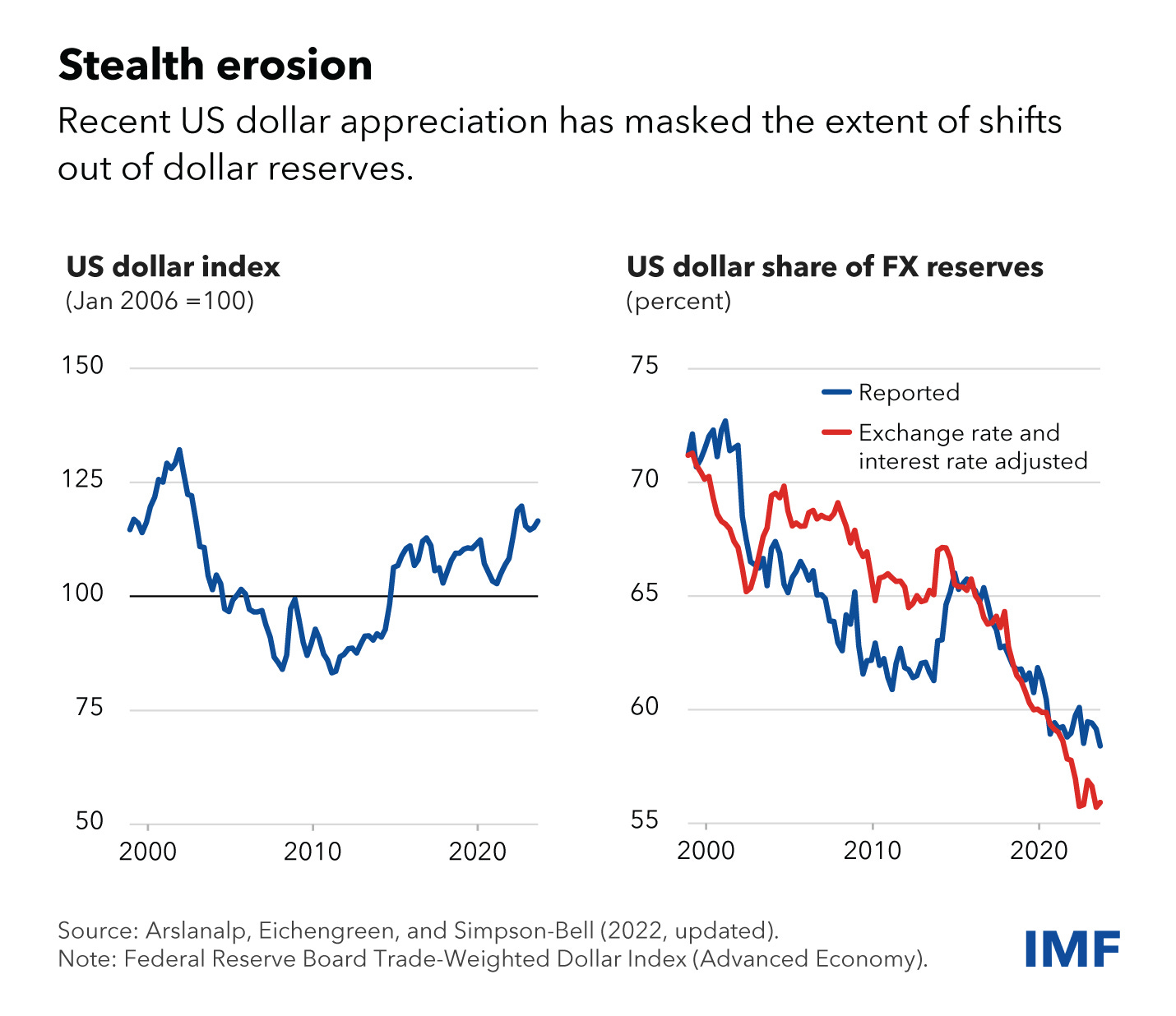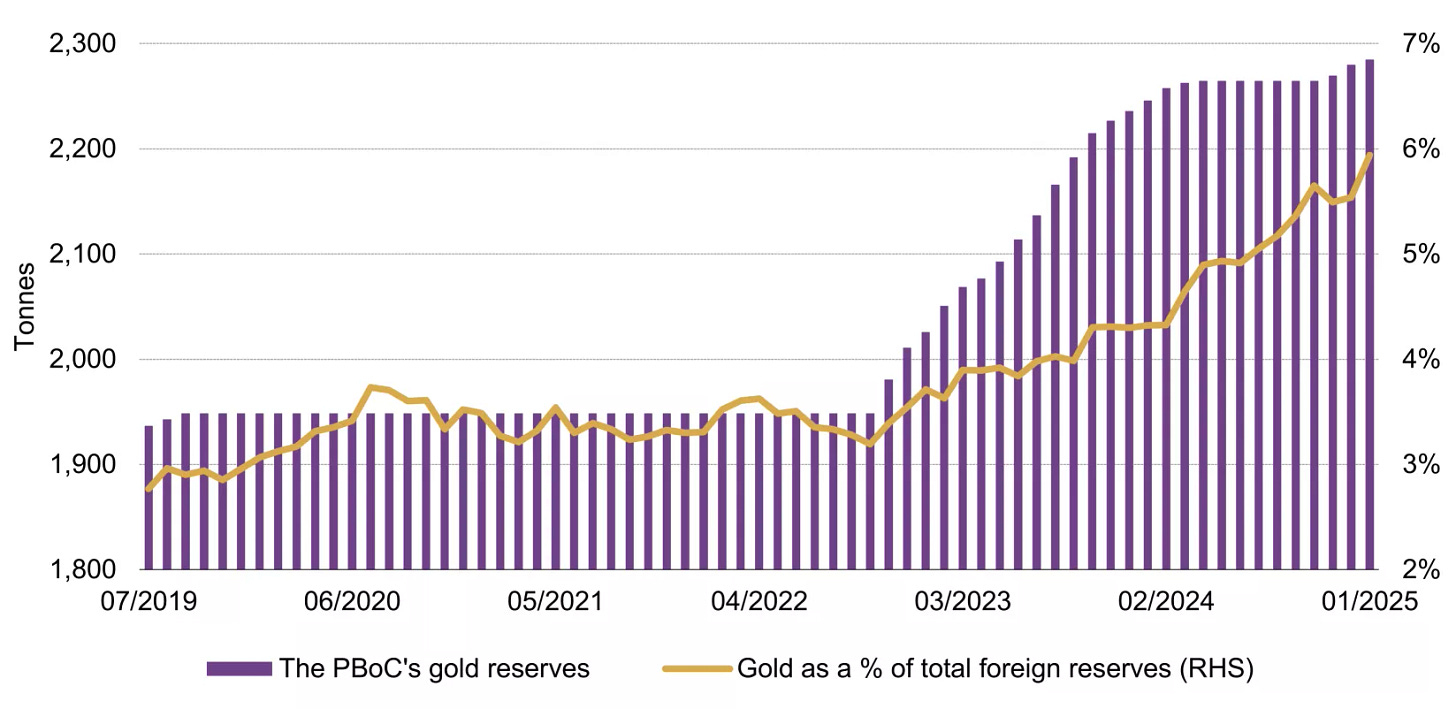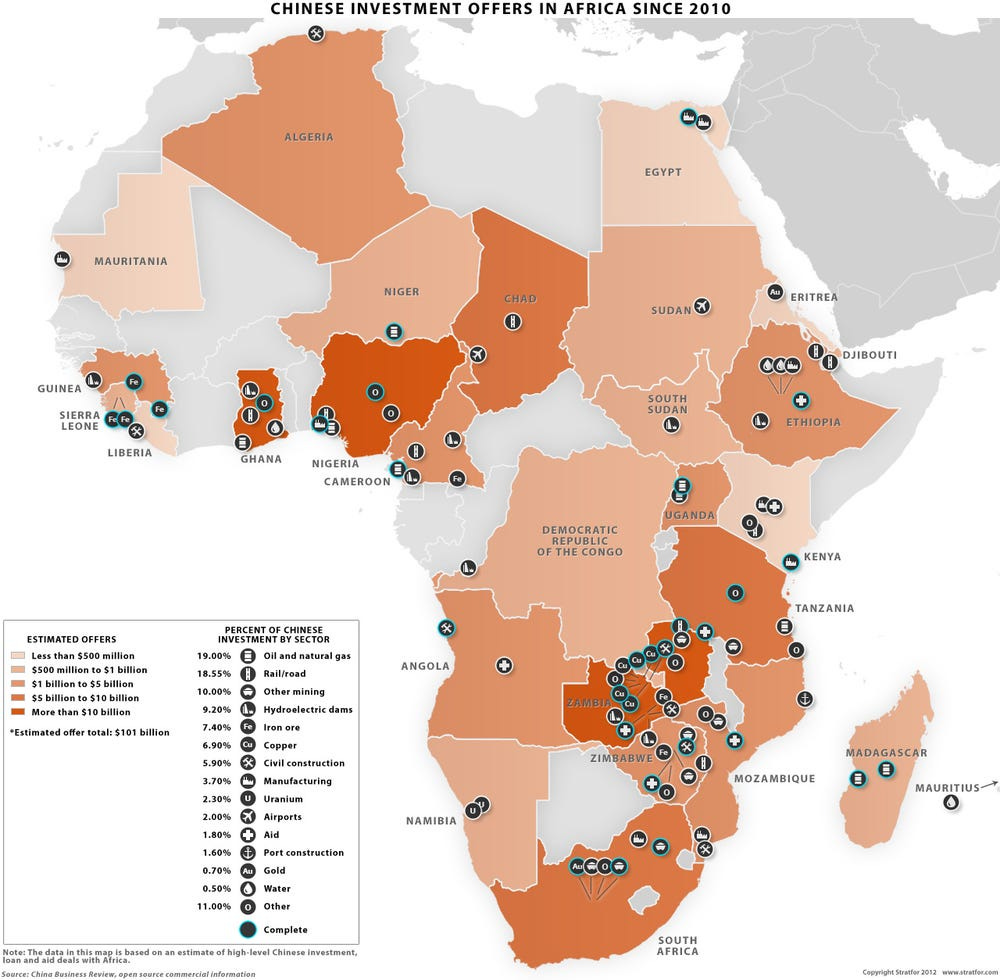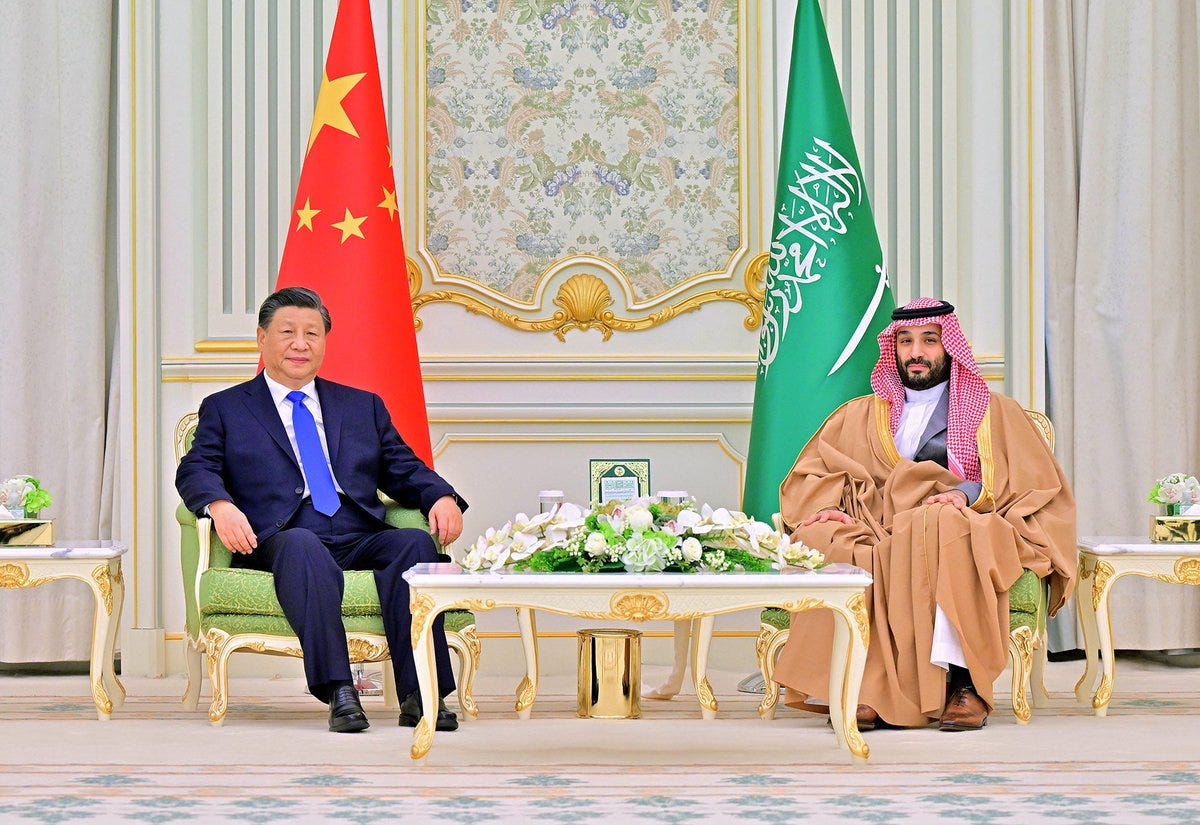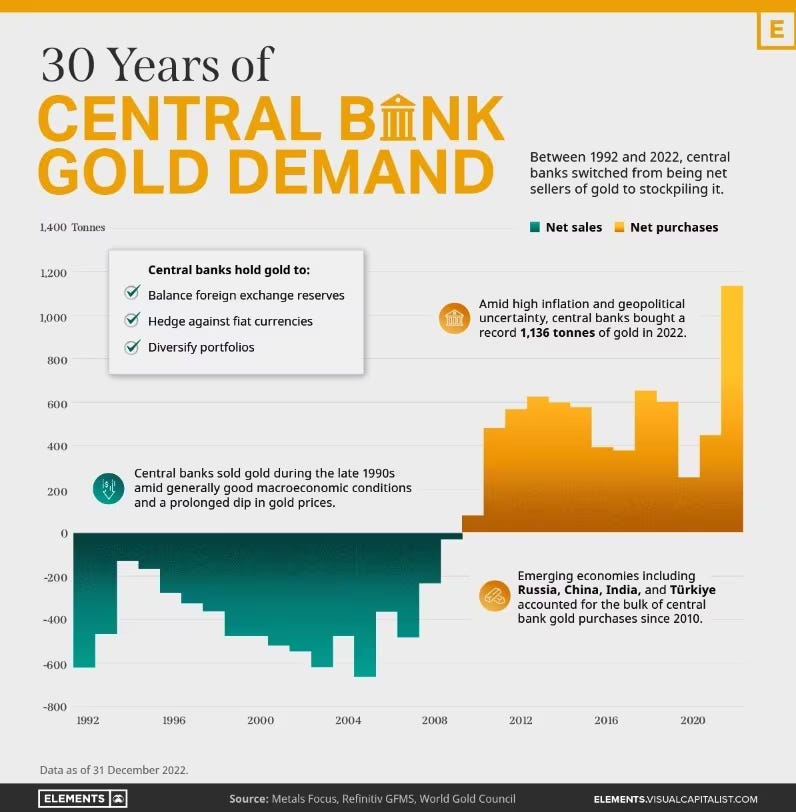Bottom Line Up front (BLUF)
Institutional consensus response to de-dollarisation asserts that there aren't currently any viable reserve-currency – while it is unlikely that another currency, like the Chinese Renminbi (CNY) will replace United States Dollar (USD) dominance – data indicates a structural transformation from unipolar dollar dominance to currency multipolarity in the global monetary system. This transition, represents a fundamental shift away from the 80-year Bretton Woods II framework toward a decentralised system characterised by diverse currency usage in international trade, investment, and reserves – utilising existing domestic currencies rather than adopting a new hegemonic alternative (CNY, BTC, etc.) .
I. Current Dollar Hegemony Metrics and Degradation Patterns
A. Reserve Currency Share Decline
USD share of global foreign exchange reserves: 71% (1999) → 58% (2022)
Continuous 14-year declining trajectory representing 1.09% annual erosion rate
Accelerated decline post-2014, correlating with increased sanctions implementation
B. Trade Settlement Transformation
China's Bilateral Trade Patterns:
Yuan usage in China's cross-border transactions reached 48.4% in March 2023, with cross-border payments totaling $549.9 billion
China-Russia trade value reached record 1.74 trillion yuan ($237 billion) in 2024
Approximately 53% of China's total trade now conducted in yuan through domestic payment systems and currency swaps
Central Bank Currency Swap Infrastructure:
China has established bilateral currency swap agreements with 29 countries/regions totaling 4 trillion yuan ($553.49 billion)
China-Nigeria currency swap renewed at 15 billion yuan ($2 billion) in December 2024
C. Gold Reserve Accumulation Patterns
Central banks added 1,045 metric tons to global gold reserves in 2024, marking the third consecutive year exceeding 1,000 metric tons annually
BRICS+ controls 42% of global central bank FX reserves, contributing to global de-dollarization processes with gold as the primary dollar alternative
II. Structural Drivers of Transition
A. Sanctions as Catalyst Mechanism
Quantitative Impact Assessment:
14,000+ sanctions imposed on Russia accelerated dedollarization across 150+ countries representing 7 billion population
Russia's ruble-for-energy mandate (2022) resulted in ruble becoming best-performing currency of 2022
Russian economy stabilization despite sanctions demonstrated multicurrency system viability despite real estate deflation and Western financial exclusion
Geopolitical Response Patterns:
UN Resolution condemning unilateral sanctions (December 2022) indicates global South consensus
80+ countries now prioritize local currency trade to mitigate sanctions exposure
B. Economic Security Considerations
Reduced Compliance Costs:
Local currency transactions eliminate AML/CTF overhead from cross-border banking complexities
Elimination of sanctions-related due diligence requirements for domestic currency transactions
Reduced foreign exchange hedging costs and cross-border banking intermediation fees
Enhanced Fiscal Capacity:
Local currency pricing improves tax/tariff collection visibility
Reduction in offshore dollar-based tax evasion through dual-pricing mechanisms
Enhanced export revenue transparency for domestic taxation
III. Multicurrency Framework Analysis
A. Operational Structure
No Hegemonic Replacement Model:
System utilizes ALL existing currencies rather than establishing new dominant currency
Eliminates need for G7 consensus or IMF/World Bank institutional reform
Bilateral agreements circumvent Western institutional veto mechanisms
Vostro Account Infrastructure:
Regional vostro accounts (Russian rubles, Chinese yuan) settle cross-border transactions
Bypasses Western banking infrastructure (SWIFT alternatives)
Domestic payment system interoperability replaces global payment system creation
B. Implementation Mechanics
Incremental Adoption Strategy:
Sector-specific testing (Russia's energy-for-rubles model)
Gradual expansion from commodity trade to comprehensive bilateral commerce
Adaptation of existing financial infrastructure rather than new system construction
Legal Framework Adaptation:
State-level legislation enabling local currency payments
Regulatory modifications for domestic banking operations
Corporate accounting system adjustments for multicurrency operations
IV. Economic Impact Assessment
A. Macroeconomic Stability Indicators
Exchange Rate Volatility Reduction:
Local currency revenues create more predictable debt servicing capacity
Reduced forex exposure for export-dependent economies
Enhanced monetary policy autonomy for participating nations
Credit Rating Implications:
Improved debt service capacity through currency matching
Enhanced fiscal revenue collection improving sovereign credit metrics
Reduced external vulnerability to currency volatility
B. Trade Efficiency Metrics
Transaction Cost Reduction:
Elimination of USD intermediation fees
Reduced hedging requirements for bilateral trade
Lower compliance costs for domestic banking institutions
Market Access Enhancement:
SME exporters gain access previously limited by commercial trade finance constraints
Reduced banking capacity requirements for cross-border transactions
Enhanced financial inclusion for smaller market participants
V. Geopolitical Ramifications
A. US Strategic Position Degradation
Monetary Policy Transmission:
Reduced global impact of Federal Reserve policy decisions
Diminished dollar demand reducing seigniorage benefits
Potential increase in US borrowing costs due to reduced Treasury demand
Sanctions Effectiveness Erosion:
Alternative payment systems reduce sanctions compliance pressure
Bilateral trade agreements create sanctions-resistant commerce channels
Reduced leverage for economic coercion through financial system exclusion
B. Emerging Market Empowerment
Enhanced Negotiating Position:
Reduced dependency on Western financial institutions
Increased bargaining power in bilateral trade negotiations
Greater monetary policy independence from Federal Reserve decisions
Regional Integration Acceleration:
Currency unions and regional payment systems development
Enhanced South-South cooperation through direct currency exchange
Reduced reliance on Western financial intermediation
VI. Risk Assessment
A. Transition Risks
Liquidity Constraints:
Limited depth in non-dollar currency markets
Potential volatility during transition periods
Infrastructure development requirements for full implementation
Coordination Challenges:
Multiple bilateral agreements create complex web of arrangements
Potential for exchange rate manipulation disputes
Technical integration difficulties between domestic payment systems
B. Systemic Vulnerabilities
Credit Rating Limitations:
BRICS credit rating agency faces data inconsistency challenges
USD dependencies in rating methodologies persist
Regulatory barriers to alternative rating system acceptance
Legal Framework Gaps:
Supranational systems (BRICS Clear) lack neutral jurisdiction for asset settlement
Dispute resolution mechanisms underdeveloped
Regulatory harmonization requirements across participating nations
VII. Probability Assessment and Timeline Projections
A. Short-term Developments (2025-2027)
High Probability Events:
Continued expansion of bilateral currency swap agreements
Increased commodity trade settlement in local currencies
Further development of regional payment system integration
Medium Probability Events:
Establishment of BRICS clearing and settlement infrastructure
Significant expansion of yuan usage in Belt and Road Initiative countries
Creation of alternative credit rating mechanisms
B. Medium-term Evolution (2027-2035)
Structural Changes:
Dollar share of global reserves declining to 40-45% range
Local currency trade comprising 60-70% of emerging market bilateral commerce
Established alternative financial infrastructure achieving critical mass
Institutional Developments:
Functional BRICS+ financial institutions operating independently
Regional monetary coordination mechanisms
Reduced Western institutional influence over global financial governance
VIII. Strategic Implications for Stakeholders
A. For Emerging Economies
Opportunities:
Enhanced monetary sovereignty and reduced external vulnerability
Improved terms of trade through direct currency exchange
Strengthened fiscal capacity through enhanced tax collection
Requirements:
Development of domestic financial market depth
Investment in payment system infrastructure
Legal framework modernization for multicurrency operations
B. For Developed Economies
Challenges:
Reduced monetary policy transmission globally
Diminished financial sector advantages from dollar intermediation
Potential increase in funding costs for government and corporate debt
Adaptation Strategies:
Development of competitive advantages in non-dollar financial services
Enhanced bilateral economic relationships with emerging markets
Investment in alternative financial technology infrastructure
IX. Conclusion
The international monetary system is undergoing fundamental restructuring from dollar dominance to multipolarity, driven by geopolitical tensions, economic security needs, and technological advances enabling bilateral currency exchange. Unlike historical transitions that replaced one hegemonic currency with another, this transformation involves diverse currency proliferation without establishing a single dominant alternative.
Key Indicators: Russia's economic stabilization despite comprehensive sanctions, China's 53% yuan usage in international trade, and extensive bilateral currency swap networks demonstrate the system's viability. The process is incremental, using existing financial infrastructure rather than requiring new institutions, making it resistant to Western vetoes.
Success Factors: Enhanced fiscal transparency and tax collection, reduced transaction costs and sanctions exposure, improved debt service through currency matching, and elimination of dollar intermediation fees. The transition proceeds through bilateral agreements and domestic regulatory changes without requiring G7 consensus.
Timeline Projections: Continued acceleration through 2035, with dollar reserve share potentially declining to 40-45% and local currency trade comprising majority of emerging market bilateral commerce. This represents evolution rather than collapse—the dollar becomes one alternative among many rather than the singular dominant medium.
Strategic Implications: Enhanced monetary sovereignty for emerging economies, reduced Western leverage through financial sanctions, and fundamental rebalancing of global economic power. Success depends on continued alternative financial infrastructure development, macroeconomic stability maintenance during transition, and effective coordination among participating economies without centralized institutional control.





